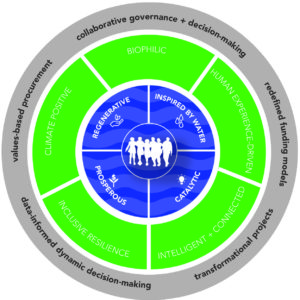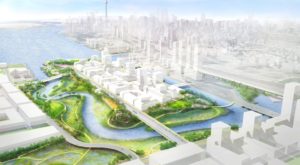A core element of Waterfront Toronto’s mandate since inception has been to lead by example when it comes to sustainable development, whether by promoting market transformation through our Minimum Green Building Requirements, undertaking complex flood protection projects, or innovative approaches to cleaning stormwater runoff.
To date, much of the sustainability work you’ve seen on the waterfront can be tied back to our corporate sustainability planning, ensuring that environmental considerations are factored into all elements of our work from the very start.
As a refresher, our first comprehensive Sustainability Framework was published in 2005. The goal of this document was to ensure that sustainability principles were integrated into all facets of waterfront revitalization, including planning, design, construction and management.
The framework also incorporated many of the leading sustainability policies across Canada, including Canada’s sustainable development strategies, Ontario’s Smart Growth strategies, and the City’s Waterfront Scan and Environmental Improvement Strategy, among others.
In 2015, Waterfront Toronto began the process of updating the Sustainability Framework. After roughly a decade, we felt it was important to review the progress we had made and brainstorm new approaches that could once again help us advance sustainable development on the waterfront.
As part of this process, we collaborated with international organizations such as C40, Cisco, the Government of the Netherlands as well as local stakeholders like the City of Toronto, Ryerson University, and The Atmospheric Fund.
 We also hosted several steering and advisory committee meetings between 2015 and 2017 – all with the intention of establishing corporate priorities for Waterfront Toronto.
We also hosted several steering and advisory committee meetings between 2015 and 2017 – all with the intention of establishing corporate priorities for Waterfront Toronto.
To help us undertake this work, we brought on the Canadian Urban Institute (CUI), a leading non-profit research organization, as our partner to help identify priorities and align with current international best practices.
Informed through both our steering and advisory committees as well as our work with CUI, we published the updated framework in 2017, now called the Waterfront Toronto Resilience and Innovation Framework for Sustainability (WTRIF).
Here, we’ll reexamine this important guiding document and explore its corresponding Action Plan.
The Core
The Resilience and Innovation Framework can be distilled into the graphic above. You’ll see that at the core of the Framework is the community.
Waterfront Toronto’s primary goal is to create places for people to live, work and play on the waterfront, so it’s only natural that we’ve placed community members at the heart of the Framework as the guiding principle of our values and practices.
Our Future
Working outwards from the core, the next ring (blue) represents the future we envision for the waterfront. Over the next 50 years, our goal is to have people recognize and experience the waterfront as:
Regenerative: Development revitalizes, restores and renews the Toronto waterfront. The ongoing process of regeneration supports healthy, connected systems and communities.
Inspired by Water: Connections to Lake Ontario and the Don river are reflected in design and operations. Waterfront revitalization respects and enhances the health of the aquatic ecosystem and connects visitors and residents to the water.
Catalytic: The waterfront is an exemplar of resilience and innovation – a place to which people and cities look for inspiration about actions that they can take to improve their own communities. Waterfront revitalization drives innovation and builds capacity locally and globally.
Prosperous: Projects create sustained economic development by leveraging a variety of innovative partnerships and funding models invested in the future of the waterfront.
Our Values
The second ring from the core (green) speaks to our values and priorities for all new development on the waterfront. These values are aspirational and their full achievement will be recognized over time. These priorities include:
Climate Positive: Guided by the C40 Climate Positive Development Program, Waterfront Toronto’s projects and initiatives support the development of low carbon communities with an aspiration to reduce greenhouse gas emissions below zero.
Inclusive Resilience: Toronto’s waterfront is a dynamic, adaptive and flexible environment with the ability to respond to technical, social and environmental changes. Buildings, communities and infrastructure are designed to survive and thrive in response to a changing climate and in times of emergency. Resilience planning considers the built, natural and social environment.
Intelligent + Connected: Technologies are used to support community needs and improve quality of life. Highspeed, resilient connectivity creates reliable connections between people and things. Access and digital inclusion build personal connections to the community.
Human Experience-Driven: Waterfront communities are healthy, safe, just, active, multi-generational, human scale and accessible. Design excellence enriches the human experience.
Biophilic: The waterfront is a place where people learn from and are inspired by nature. Buildings and infrastructure incorporate natural forms and systems into the design and operations.
Our Practices
The outer ring (grey) speaks to our practices. This is how we intend to implement our values and achieve our envisioned future:
Collaborative Governance and Decision-Making: Governance processes achieve a stewardship ethic, support capacity building and provide inspiration through engagement and education. There is a focus on creating models for more inclusive decision-making.
Redefined Funding Models: Redefined partnerships include public-private partnerships, partnerships with non-profits, pension funds, industry and academia to realize sustainable economic development.
Transformational Projects: Innovative projects demonstrate leadership and the feasibility of innovative approaches locally, nationally and internationally. They provide Waterfront Toronto a means of assessing, procuring, funding and delivering new technologies and ideas.
Data-informed Dynamic Decision-making: Data is collected on the performance of projects to track, learn from and improve future performance. Learnings are shared internally and externally. Decisions are informed by accurate, timely and appropriate data sets.
Values-Based Procurement: To achieve innovation and development that is aligned with our values and our future, Waterfront Toronto’s procurement processes factors in addition to price, such as the impact on society, the environment and the local economy.
All of these elements combined represent a framework of our approach to sustainability and resiliency. To put these concepts in motion, we also created an Action Plan that identifies initiatives that promote sustainable and accessible communities along the waterfront.
Our Action Plan
 Our mandate calls for us to play a multi-faceted role along the waterfront, from master planner and developer to innovation leaders, but it also calls for us to be a catalyst.
Our mandate calls for us to play a multi-faceted role along the waterfront, from master planner and developer to innovation leaders, but it also calls for us to be a catalyst.
Many of the action items required to create a sustainable community on the waterfront are beyond the scope of our mandate and we will need the support of others to drive meaningful change.
To this end, the Action Plan outlines various long-, medium- and short-term initiatives that are designed to be executed through the combined effort of Waterfront Toronto and other partner organizations.
To date, we’ve already made meaningful progress on the Action Plan. For instance, when creating our Villiers Island Precinct Plan, we also conducted a climate positive pathway assessment for the community, which allowed us to identify the optimal building orientation and massing to reduce building energy demand on the island. These findings were incorporated into the precinct plan.
To support equity and digital inclusion, we have been working with our telecommunications partner, Beanfield Metroconnect, to provide equitable wifi access across the waterfront including free internet services in affordable housing unit as well as throughout public parks and other areas along the waterfront.

Images from the Villiers Island Precinct Plan.Left: technical carbon modelling for the future Villiers Island; Right: diagram illustrating solar access during the winter months on the future Villiers Island.
We’ve also been thinking about how we can implement a whole host of action items at the Quayside site. Our Request For Proposal for an Innovation and Funding Partner for Quayside called for considerations around realizing a path towards climate positive for the community, identifying strategies to support the future community in managing the shocks of a changing climate, and growing an innovation corridor along the waterfront.
Looking to the future, we are excited to make progress on the Action Plan in two meaningful ways that will set the stage for future work towards our Climate Positive and Intelligent + Connected objectives. First, we are working on an update of our Minimum Green Building Requirements to ensure that the developments in our waterfront communities continue to advance sustainable building design and contribute to our climate positive objective.
Second, in consultation with members of the community and digital experts, we are establishing Intelligent Community Guidelines for any technology-enabled project proposed for the neighbourhoods we create. This will ensure, protect and enhance equity, privacy and fundamental freedoms, while also fostering opportunities for the local technology ecosystem to participate in the next phase of revitalization. We are looking forward to bringing these plans to the community for consultation in the coming year.
With the help of CUI and our Steering and Advisory Committees, we’ve been able to establish a path forward for sustainable development on the waterfront grounded in our values and aspirations outlined in the Resilience and Innovation Framework for Sustainability.
All images are courtesy of Waterfront Toronto.
Read the full Action Plan (PDF).
This article by Emma Loewen originally appeared on the Waterfront Toronto website.
Reprinted here (with minor edits) by permission.

